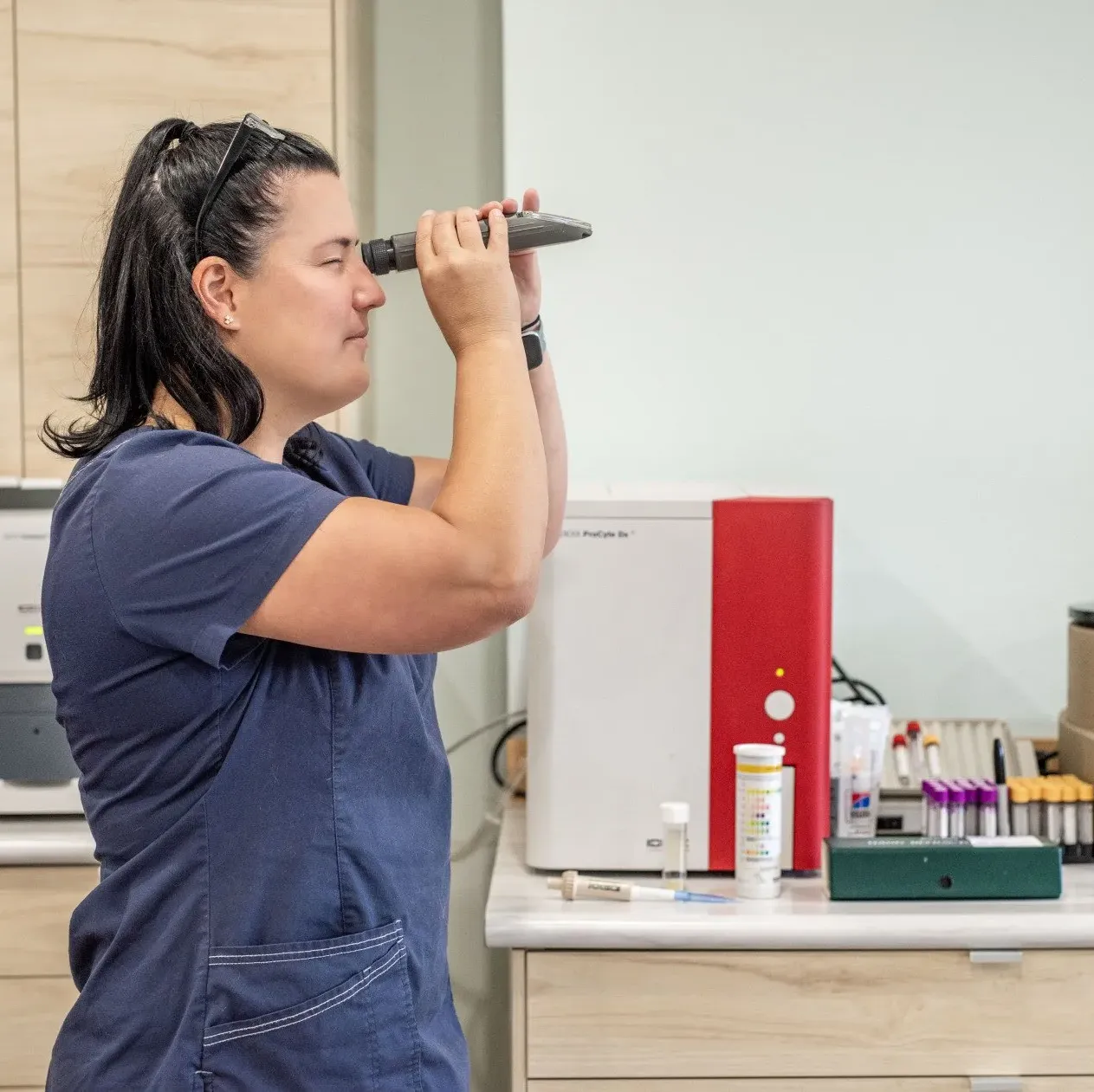IN HOUSE DIAGNOSTICS

You love your pet, you know their daily routine, their favorite toys and all of your best friend’s little quirks. However, when your furry friend feels unwell, they can’t tell you where it hurts or what is wrong. This is when we turn to diagnostic tests, to allow us to gain a deeper understanding into your pet’s health.
We are proud to offer an in-house laboratory, dental and full body X Rays and an ECG machine. Comprehensive in-house diagnostics allow us to receive your pet’s results sooner, all in the same location.
What can be found in blood work?
There are two main components to routine blood work:
Complete Blood Count (CBC):
This provides detailed information about your pet’s red and white blood cells and platelets. Conditions such as anemia, bleeding, inflammation, infection or even immune system disorders can be diagnosed by analyzing your pet’s blood cells.
Chemistry:
The chemistry component of blood work analyzes various proteins, enzymes and other chemicals in the blood stream which are used to assess the health of internal organs. Chemistry can help diagnose liver and kidney disease, it can also indicate signs of hormonal disease such as Cushing’s disease and Diabetes.
Blood work is recommended:
- Before anesthesia or surgery.
- For general wellness check ups to gather your pet’s baseline values
- For early detection of diseases which may only show no or very subtle symptoms
- When your pet is unwell.
- Prior to starting certain medications.
Blood work is one of the fastest and minimally invasive tests which provides us a wealth of knowledge about your pet’s internal health. This is why we have in house blood machines that can perform a variety of tests to allow us to give you prompt, and in some cases, same day, results so we can get your pet on the road to recovery as soon as possible.
A urine test is assessed for:
- Color and appearance
- Microscopic appearance such as red or white blood cells, cancer cells, mucus, bacteria, protein, crystals
- Concentration
- Chemical components such as glucose, protein, bilirubin, blood, ketones
The most common reason we request a urine test is when a client is concerned their pet has a bladder infection. However, urine tests are an essential part of diagnosing some very serious diseases such as Diabetes, kidney disease and Cushings disease.
Our In-House Urinalysis machine allows us to assess your pet’s urine quickly and accurately, allowing us to report your pet’s results as soon as possible. This means you can get your pet on the road to recovery sooner and means a few less potential “accidents” to clean off the carpet.
X-rays are often associated with diagnosing broken bones, however, there is so much more we can learn about your pet’s condition from radiology.
Xrays help us assess the condition of your pet’s:
- Digestive system, including the stomach, liver and intestines
- Heart and lungs
- A variety of other abdominal organs, including the kidneys, bladder and the prostate
- The oral cavity, especially the teeth and surrounding structures.
- Joints and bones
- The spine.
Radiographs can be captured quickly and painlessly, so you don’t need to worry about stressing out your pet any further. In some cases, sedation or anaesthesia may be required, and our veterinarian will discuss this with you ahead of the procedure. Modern x-ray technology also produces far less radiation than older machines, so you can rest assured that the procedure is safe for your pet.
Once we have completed the x-ray, we’ll get the images almost instantly so we can start examining your pet’s results. In complex cases, we do also have the opportunity to send images to a radiologist for a specialist opinion.
Whether we are diagnosing problems or ruling out possible causes, x-rays are an extremely valuable diagnostic tool in the treatment process.
Our ECG machine is very helpful for patients with potential cardiac problems but is also a very useful tool in pre-anesthetic screening.
Our veterinarian may recommend an electrocardiogram to:
- Assess the electrical activity and health of the heart prior to undergoing an anesthetic to assess anesthetic risk and maximize patient safety.
- Assess cardiac function in patients who are clinically normal but have a heart murmur or abnormal heart rhythm (arrythmia)
- Take an ECG reading for direct submission to a cardiologist by our CardioPet telemedicine portal.
An ECG is a painless and quick way to detect potential underlying heart problems, which can allow us to pursue further diagnostics and treatment earlier in the disease process to give your pet the best chance at a long and happy life.
These sound waves bounce back off different tissues and materials within the body. The reflected waves are then used to build a picture of what is going on inside. There is no radiation involved — only totally harmless sound waves.
When using ultrasonography to see inside your pet we can check out the following:
- The health of tendons and ligaments
- The structure and blood flow of the heart
- The health of your pet’s internal organs such as the stomach, intestines, liver and spleen.
- Examine the bladder and reproductive tract.
- The presence of foreign objects that may have been swallowed or otherwise ended up inside your pet
Your pet might be a bit curious about what’s going on but it is pain free and a wonderful non invasive diagnostic tool.

